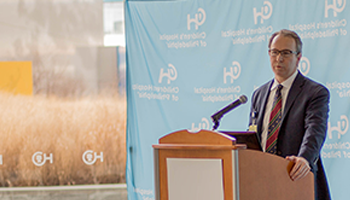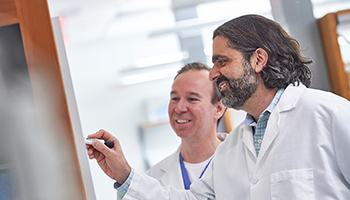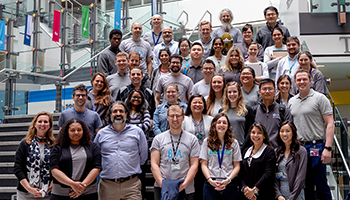HOW CAN WE HELP YOU? Call 1-800-TRY-CHOP
In This Section
Balancing the Bench and the Bedside: Q&A With Jay Storm, MD

During Childhood Cancer Awareness Month and year-round, we love to see our patient families invested in our cancer research at Children’s Hospital of Philadelphia – whether it’s by attending events like the Parkway Run & Walk or just sheer curiosity about the projects our scientists have in the works.
One clinician-researcher who knows just how much bench and bedside are intertwined is Phillip “Jay” Storm, MD, who works in the best of both worlds, practice and research, as he balances his roles as chief of the Division of Neurosurgery and co-director of the Center for Data-Driven Discovery and Biomedicine (D3b Center). D³b’s scientific expertise and diverse research platforms target pediatric cancers and diseases of childhood development, with pediatric brain tumors as a driving area of research emphasis.
In this Q&A, we sat down with Dr. Storm to learn about the many links between research and practice at D3b, as well as the importance of transdisciplinary cancer research.
Can you describe what it's like to be both co-director of the D3b Center and an attending neurosurgeon?
What we want to do is narrow the divide between the clinical and research teams, so that almost everything in clinical work is D3b, and everything D3b is clinical. In that way, both sides are constantly supporting each other back and forth. And, by being on both ends, I think I've been able to really enable that. I love being able to facilitate tissue acquisition but then also be a leader on the clinical side.
What motivated you to immerse yourself on both ends of the bench and bedside?
The whole reason I started doing this in the first place was that while extensive resection (surgically removing a tissue) is extraordinarily important, and is correlated in the outcome of almost every tumor we remove, the sad truth is that even when we remove all of a tumor, many times it comes back. Without better understanding of the tumor biology, [surgery] will never be able to cure the kids or even adults with these diseases.
So, for me, it wasn't enough to just tell the family, “Oh, the resection was great, the MRI looks perfect, your child has no deficits. I've done all I can, but it's up to the radiation or chemotherapy now.” That never sat well with me. They are my patient from the time I treat them to the time they're cured or they die.
 And so, working with the team we have at the D3b Center, especially my partnership with Adam [Resnick] who this all started with, has provided the greatest source of hope for me – real hope, which I don’t think I would have if I were not part of D3b. Adam and I met back in 2000 at Johns Hopkins, when I was a fifth-year neurosurgery resident, and he was a first-year neuroscience graduate student. It is now 20 years later, and my partnership with Adam is without a doubt the most rewarding part of my job.
And so, working with the team we have at the D3b Center, especially my partnership with Adam [Resnick] who this all started with, has provided the greatest source of hope for me – real hope, which I don’t think I would have if I were not part of D3b. Adam and I met back in 2000 at Johns Hopkins, when I was a fifth-year neurosurgery resident, and he was a first-year neuroscience graduate student. It is now 20 years later, and my partnership with Adam is without a doubt the most rewarding part of my job.
Would you say that being a scientist in the lab helps you become a better clinician, and vice versa?
Yes, especially with what’s happening now with technology. Technology is changing both research and clinical practices, so by doing novel and innovative procedures in the operating room, we attract more patients to our hospital, which then allows us to enroll more patients in research projects. Those discoveries inform how we do surgery to improve outcome and reduce risk. This reduced time from clinical treatment to laboratory discovery back to novel clinical treatment is why Adam and I formed D3b.
We are part of an international consortium called the Children’s Brain Tumor Tissue Consortium (CBTTC) which has allowed participating investigators to accumulate a lot of tissue and then do bench research. As a good example of this, we recently discovered something totally unexpected that we're hoping to submit early for publication in the next month or two. This discovery is likely going to affect how we do surgery based on adjuvant therapy. So, instead of taking [the tumor] all out with a high risk of postoperative deficits, we only need to get a little bit of tissue to confirm the diagnosis and then put them on a medication that would stop [the cancer] from growing. So, innovation in the clinic has led to innovation in research, which is going to come back and actually change the way we do the surgery.
What other projects were you really excited to watch go from the bench to the bedside?
Over the last 10 years, in partnership with Angela Waanders, MD, MPH, who is now head of Precision Medicine at Ann & Robert H. Lurie Children’s Hospital of Chicago, we had focused on low-grade gliomas. From that work, we are developing different treatments for low-grade gliomas based on genetic abnormalities in the MAP kinase pathway.
Because of our expertise in low-grade glioma work, we discovered that at the protein level, you cannot tell a portion of low-grade gliomas apart from other tumors that look very different under the microscope. These tumors have different cells of origin, and one would not predict that they would be similar. But in fact, at the protein level and from their immune signature, they look very similar. This could be a potential target that we will start investigating.
The other area that I am excited about is drug development and drug testing. As we discover new genes that are contributing to a cell’s transformation into a cancer cell, there are new opportunities to target these cell with new drugs. In the case of some tumors, the drugs already exist.
One exciting example is a drug that targets tumors with NTRK gene fusions. These drugs are showing outstanding efficacy against a wide range of tumors in and out of the central nervous system. Because of our tumor collaborations, we have several samples stored that were not previously clinically tested for an NTRK gene fusion. We can go into the biorepository and potentially identify patients who have this mutation, and some could possibly be a candidate for this new drug therapy.
What would you like patients and patient families to know about what’s going on within D3b?
I would sa y D3b is continuing to accelerate discoveries in pediatric cancer through collaborative researchers around the world because of our big data focus and our platforms. One of the goals of D3b is to attract researchers from all different types of cancer – adult and pediatric – that come to our platforms to not only empower their data, but also to look at ours and to advance the field of pediatric brain tumors in ways that I don't think people even thought of even six or 12 months ago.
y D3b is continuing to accelerate discoveries in pediatric cancer through collaborative researchers around the world because of our big data focus and our platforms. One of the goals of D3b is to attract researchers from all different types of cancer – adult and pediatric – that come to our platforms to not only empower their data, but also to look at ours and to advance the field of pediatric brain tumors in ways that I don't think people even thought of even six or 12 months ago.
Let’s talk about the transdisciplinary nature of the D3b Center and why it’s important to cross borders in research and practice.
The D3b Center takes a transdisciplinary approach: It’s engineering, it's biology, it's oncology. It's not just the traditional research approach that focuses within one area, and it’s not just a bunch of different medical disciplines coming together. Through a transdisciplinary approach, what used to be disparate fields, like engineering or mathematics, comes together to become bioinformatics.
And what we now know is that understanding the DNA is not enough. Even when people have identical DNA, for example identical twins, they do not always develop the same diseases. This is because there are multiple factors at work beyond the DNA.
The metaphor we like to use is that the DNA is the canvas onto which the RNA, the proteins, the environment, epigenetics are added to make the final piece that is the individual human being. So the canvas never changes, but you can paint over it, you can transform it. And that’s why we developed this transdisciplinary center. Although the DNA is exactly the same, the painting in certain cells or other cells is constantly changing.
Learn more about Dr. Storm at the D³b Center website.